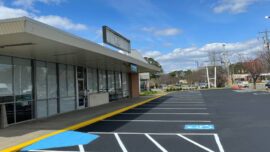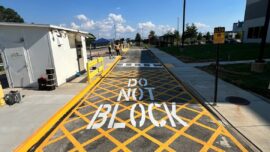Frequently Asked Questions
How Do I Prepare for Striping?
Parking lot striping is straightforward, especially when completed by a skilled contractor. However, there are many things to do to prepare, ensuring contractors can complete the job without a hitch. Before striping or restriping a parking lot, here are a few preparation steps.
- Address Cracks and Damage: The last thing you should do is ignore visible signs of damage. Cracks, potholes, surface defects, and other issues can ruin the look of pavement markings. Even worse, they can invite water to penetrate the surface, resulting in severe damage. Hire contractors to fill cracks, perform patches, and repair all damage before scheduling your striping appointment.
- Arrange for Temporary Parking: Vehicles and pedestrians must stay off your pavement as contractors work. To reduce frustration and avoid major disruptions to your business, make arrangements for alternative parking locations well before your appointment. Have a set place for employees and visitors to park.
- Provide Notification and Redirect Traffic: Give those affected by striping service plenty of notification. Alert employees at least a week in advance to avoid any surprises. On the day of, place barricades to prevent drivers from entering your parking lot and use signage to direct them to alternative parking areas.
- Clean Your Pavement: Parking lot striping paint will only adhere to clean, dry pavement. Clean the pavement by sweeping away dirt and debris. If necessary, wash the surface several days before your striping appointment to ensure the pavement has time to dry before contractors arrive.
- Ensure All Sprinklers Are Off: Finally, don’t forget to turn off sprinkler systems. Contractors recommend doing so at least 12 hours before your service appointment. If your parking lot has significant shade, turn off sprinklers 24 hours early to allow the pavement to dry.
How Often Is Parking Lot Striping Needed in Richmond, VA?
Parking lot striping isn’t a one-and-done affair. Striping fades with time and exposure, so you must invest in restriping services regularly to maintain vibrancy and ensure safety. How often you need to restripe parking lot surfaces depends on many factors, including the amount of traffic your property receives, the level of exposure to the elements it has, recent weather conditions, the quality of paint utilized, and more.
Generally, contractors recommend restriping your parking lot once your existing lines lose about 25 percent of their visibility. For most parking lot lots using standard paint, that’s usually every 18 to 24 months.
The best approach to developing a striping schedule for your property is to work with a reputable contractor. Experts can visit your parking lot for regular inspections. They apply their skills to assess the condition of existing paint, all while considering factors like wear and exposure to let you know when it’s time for a refresh. They can help you stay on top of striping maintenance, ensuring good visibility at all times.
How to Find the Right Markings for Warehouse Striping?
Stripes and markings can turn even the biggest warehouses into beacons of productivity. However, the benefits you have to gain depend on the markings you use and the quality of paint applied. When applying lines and floor markings, contractors can use various formulas. Standard water- or solvent-based paints offer affordability. However, more premium alternatives can last significantly longer, making them a more viable choice for long-term savings and durability in high-traffic warehouses.
Efficiency and maximum productivity are top priorities for warehouse floor marking design. Analyze your daily operations, note safety hazards, and study how employees navigate the warehouse. You can implement many types of markings into your warehouse design, including lines that separate pedestrian and equipment traffic, markings that help improve organization, and striping that alerts workers to safety concerns. When developing a design, work with contractors with warehouse floor marking experience. They can help you create a design that makes sense for your property. You can also utilize temporary tape to test layouts, adjust designs, and adapt until you get results that benefit your warehouse.
Why Asphalt Sealcoating?
There are many reasons to seal your parking lot. Sealcoating is a form of preventative maintenance that can help mitigate the effects of damaging factors like sun exposure, rain, road chemicals, leaking vehicle fluids, regular wear and tear, and more. Asphalt is a highly durable material, but it’s not immune to the effects of exposure. Over time, exposure to the elements and wear can lead to oxidation. Your once durable and pliable asphalt becomes brittle and crack-prone, increasing the risk of damage.
Sealcoating prevents that, acting as a shield against damaging elements. When done regularly, sealcoating can prevent your parking lot from encountering major issues, ultimately prolonging its lifespan.
It also helps improve curb appeal. Parking lot sealcoating is transformative, restoring the glossy black finish of fresh asphalt and giving your pavement a like-new look at a fraction of the cost.
What Is the Process for Asphalt Repair?
All repair projects begin with a thorough inspection of the damage. Contractors assess the problem to determine the best repair approach. From there, teams clean the area to remove dirt and debris. Then, they can proceed with the chosen repair technique.
For standard cracks, contractors may route the area before using a specialized filler and sealer. Crack filling and sealing helps prevent the damage from spreading while also preventing water intrusion. Larger issues may require asphalt patching, which involves removing the damaged material before refilling the newly created void with new asphalt. After compaction and curing, your pavement is ready for action.
What Types of Paint Are Used for Parking Lot Striping?
Contractors can use many different types of paint for striping. Water-based or solvent-based paints formulated for traffic use are the standard. However, higher-quality formulas are also available for greater durability.
Parking lots typically utilize yellow paint for striping. However, certain features may require other colors for code compliance. For example, accessible parking stalls require blue markings. Meanwhile, fire lanes need red paint for easy identification.
What Is the Life Expectancy of Parking Lot Striping?
Standard parking lot striping lasts one to two years. However, that all depends on exposure, wear, and the type of paint used. More durable paint options can last several years longer. Hire contractors to inspect your striping regularly to ensure you invest in restriping services at the right time for optimal visibility.
How Long Does It Take for Parking Lot Striping to Dry?
Drying times depend on the weather. Most parking lot paint will dry within two hours in warm and dry conditions. On new or freshly sealed pavement, it can take longer. Asphalt sealers take 24 to 48 hours to cure, prolonging the striping process.



